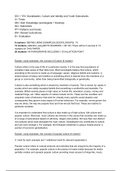SCI + YS= Socialisation, Culture and Identity and Youth Subcultures
X= Times
OK= Own Knowledge (sociologists + theories)
SC= Subculture
PT= Patterns and trends
DS= Deviant subcultures
E= Evaluation
6 markers- DEFINE USING EXAMPLES (SOCIOLOGISTS) 1X
12 markers- definition using BOTH SOURCES + OK 3X= There will be 2 sources in 12
markers for THIS PAPER
20 markers- 4X PARAGRAPHS INCLUDING 1 EVALUATION POINT
Explain, using examples, the concept of Culture (6 marker)
Culture refers to the way of life of a particular society. It is the way that populations of
societies make sense of their daily lives. Most sociologists believe that culture, which
according to the source is made up of language, values, religious beliefs and customs. A
shared sense of history and tradition is something which is learned from the members of a
group or community, rather than being transmitted biologically or genetically.
Culture is also something which is shared by members of society. This is shown by values in
society which are widely accepted beliefs that something is worthwhile and desirable. For
example, British society places a high value on human life, education, proacy, money and
material things, etc. Other aspects of culture include norms. These are the unwritten and
unspoken rules of behaviour that exist for virtually every specific social situation and
consequently they govern every aspect of human behaviour. For example, norms govern the
way we dress, the way we prepare food and how we eat that food. These are relative to
particular societies.
It is important to understand that culture is also made up of high culture, folk culture and
popular culture. Moreover, most cultures are diverse in this sense that societies are made up
of a range of subcultures based on ethnicity, religion and politics. All have their own distinct
min-cultures which exist alongside the main culture. Globalisation too contributes to culture
and can even change it. For example, the Ethiopian tribesmen is using a mobile phone- a
symbol of economic globalisation.
Explain, using examples, the concept of popular culture (6 marker)
(1 mark for each example and 1 additional mark for relevant explanation)
Popular culture refers to cultural products and activities that are enjoyed by the majority of a
population. For example, popular culture is the product of mass media because he media
partially creates and spreads popular culture providing mass access to things like, music,
, films and sports. This shows how there is a domination of mass produced entertainment.
Popular culture may also be an example of listening to pop music and watching television.
Leisure activities may include shopping and products that are consumed may be reading
magazines, tabloid newspapers or popular fiction. However, some groups may not have
access to these resources especially when going to the theatre or playing golf. Mostly those
of the MC associate with these activities as they come from a high culture whereas
working-classes may go to the cinema instead because they have a low economic/cultural
capital, as argued by Bourdieu.
Another perspective on popular culture is the postmodern approach which suggests that it
can no longer be classed as mass culture. Strinati argues that there exists a wide variety
and therefore massive choice of cultural products within popular culture. For example,
popular television shows like Eastenders and Hollyoaks have encouraged public discussion
of social problems whereas social networking sites like Facebook and Twitter may have
made people more aware of particular issues and increased the pressure on politicians. This
also shows that high culture and popular culture is being mixed and matched. For instance,
classic culture is adapted into popular television as television coverage of the football World
Cup was sound-tracked by classical music. Popular culture can also be described as the
‘dumbing down’ of cultures as most individuals were likely to interact with celebrity-obsessed
consumer culture and because a good deal of popular culture is mass-produced by media
companies for instant consumption in order to make profit rather than art.
Explain, using examples, the concept of high culture (6 marker)
High culture refers to cultural products and activities which are seen as intellectually and
aesthetically superior because they supposedly represent the highest levels of human
creativity. For example, includes middle class have a high status and wealth who associate
with these activities. For example, by going to the theatre to watch Shakespeare plays or
playing golf. Other high culture products/activities include, classical music, art, opera and
ballet. Whilst the working-classes who may not have a high economic capital, as argued by
Bourdieu may consume in activities that are ‘mass culture’ in representing inferiority and the
‘dumbing down’ of the masses. Therefore, he suggests that high culture represents the
capitalist class which can use its economic and political power. This can mean that their
power can impose their definitions of moral and artistic worth on the rest of society via the
mass media and education system. Hence, high culture is seen as superior to other forms of
culture by some individuals.
The distinction between high culture and popular culture is no longer clear because
technology such as the internet had made all cultural products available to everyone. For
example, people no longer have to leave their homes to visit an art gallery because many art
treasures can be seen online. Moreover, postmodernists argue that popular culture and high
culture are increasingly being mixed and matched. For instance, classic culture is adapted
into popular television as television coverage of the football World Cup was sound-tracked
by classical music.
Explain, using examples, the concept of Consumer culture (6 marker)





